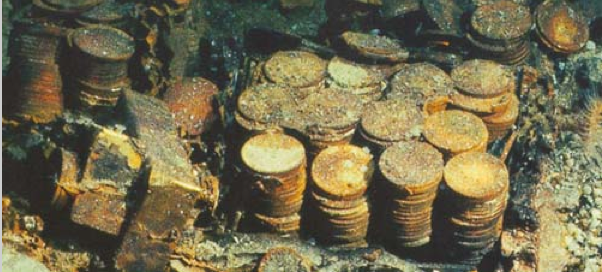Encyclopedia Dubuque
"Encyclopedia Dubuque is the online authority for all things Dubuque, written by the people who know the city best.”
Marshall Cohen—researcher and producer, CNN
Affiliated with the Local History Network of the State Historical Society of Iowa, and the Iowa Museum Association.
PANIC OF 1857: Difference between revisions
No edit summary |
No edit summary |
||
| Line 7: | Line 7: | ||
The economic panic struck this city by October, 1857. (3) The banking houses of Flaven & Co., Flinn & Bro. and A. C. Pearson suspended business. In January, 1858, Gray & Waldron and C. W. Arthur closed. Mass meetings of citizens demanded that the harbor companies should issue more of their own notes to relieve the situation. (4) First Congregational Church which had moved twice in its short history had to curtail work on its new church. Services were held in the basement of the unfinished building. | The economic panic struck this city by October, 1857. (3) The banking houses of Flaven & Co., Flinn & Bro. and A. C. Pearson suspended business. In January, 1858, Gray & Waldron and C. W. Arthur closed. Mass meetings of citizens demanded that the harbor companies should issue more of their own notes to relieve the situation. (4) First Congregational Church which had moved twice in its short history had to curtail work on its new church. Services were held in the basement of the unfinished building. | ||
The entire number of business houses which suspended business or closed during October, November and December, 1857, and the first half of January, 1858, was sixty-one. (5) Dubuque which had one-tenth of the businesses in the state and even less a percent of its population had one-third of the business failures and over half of the dollar value of liabilities of the state in 1857. (6) Although Dubuque had less than .1 percent of the nation's population it accounted for more that one percent of the nation's business liabilities in 1858 and 1859. (7) | The entire number of business houses which suspended business or closed during October, November and December, 1857, and the first half of January, 1858, was sixty-one. (5) Dubuque which had one-tenth of the businesses in the state and even less a percent of its population had one-third of the business failures and over half of the dollar value of liabilities of the state in 1857. (6) Although Dubuque had less than .1 percent of the nation's population, it accounted for more that one percent of the nation's business liabilities in 1858 and 1859. (7) | ||
--- | --- | ||
Revision as of 02:21, 16 April 2015
PANIC OF 1857. At the beginning of 1857 businesses in which banks had invested were failing. Investors were losing heavily in the stock market. Railroads were unable to pay their debts. Land speculators who had counted on the construction of new railroad routes were losing money. People fearing financial ruin attempted to withdraw their money, but the banks did not deal in paper currency. They used gold. With their failed investments, it was impossible for the banks to gather all the gold their customers demanded. (1)
Hopes for a financial rescue lay below the decks of the ship “Central America” which was bringing ten tons of gold with a value of $2 million of dollars from California to shore up eastern banks. On August 24, 1857, however, the ship was sunk by a violent hurricane off the coast of Florida. (2)
The effect was immediate. On August 24, 1857, failure of the New York branch of the Ohio Life Insurance and Trust Company led banks across the nation to collapse within months. The Panic of 1857, a severe economic depression in the United States, lasted three years. (3)
The economic panic struck this city by October, 1857. (3) The banking houses of Flaven & Co., Flinn & Bro. and A. C. Pearson suspended business. In January, 1858, Gray & Waldron and C. W. Arthur closed. Mass meetings of citizens demanded that the harbor companies should issue more of their own notes to relieve the situation. (4) First Congregational Church which had moved twice in its short history had to curtail work on its new church. Services were held in the basement of the unfinished building.
The entire number of business houses which suspended business or closed during October, November and December, 1857, and the first half of January, 1858, was sixty-one. (5) Dubuque which had one-tenth of the businesses in the state and even less a percent of its population had one-third of the business failures and over half of the dollar value of liabilities of the state in 1857. (6) Although Dubuque had less than .1 percent of the nation's population, it accounted for more that one percent of the nation's business liabilities in 1858 and 1859. (7)
---
Source:
1. "S. S. Central America," http://en.wikipedia.org/wiki/SS_Central_America
2. Ibid.
3. Ibid.
4. Oldt, Franklin T., History of Dubuque County, Iowa. Chicago: Goodspeed Historical Association, 1880. http://www.ebooksread.com/authors-eng/franklin-t-oldt/history-of-dubuque-county-iowa-being-a-general-survey-of-dubuque-county-histor-tdl/page-14-history-of-dubuque-county-iowa-being-a-general-survey-of-dubuque-county-histor-tdl.shtml
5. Ibid.
6. Johnson, Russell Lee. Warriors Into Workers: The Civil War and the Formation of Urban-industrial Society in a Northern City. Fordham University Press, 2003. p. 30 Online: http://books.google.com/books?id=ahqtg54TXyEC&printsec=frontcover&source=gbs_ge_summary_r&cad=0#v=onepage&q&f=false
7. Ibid.



